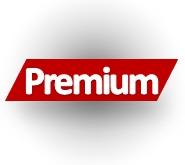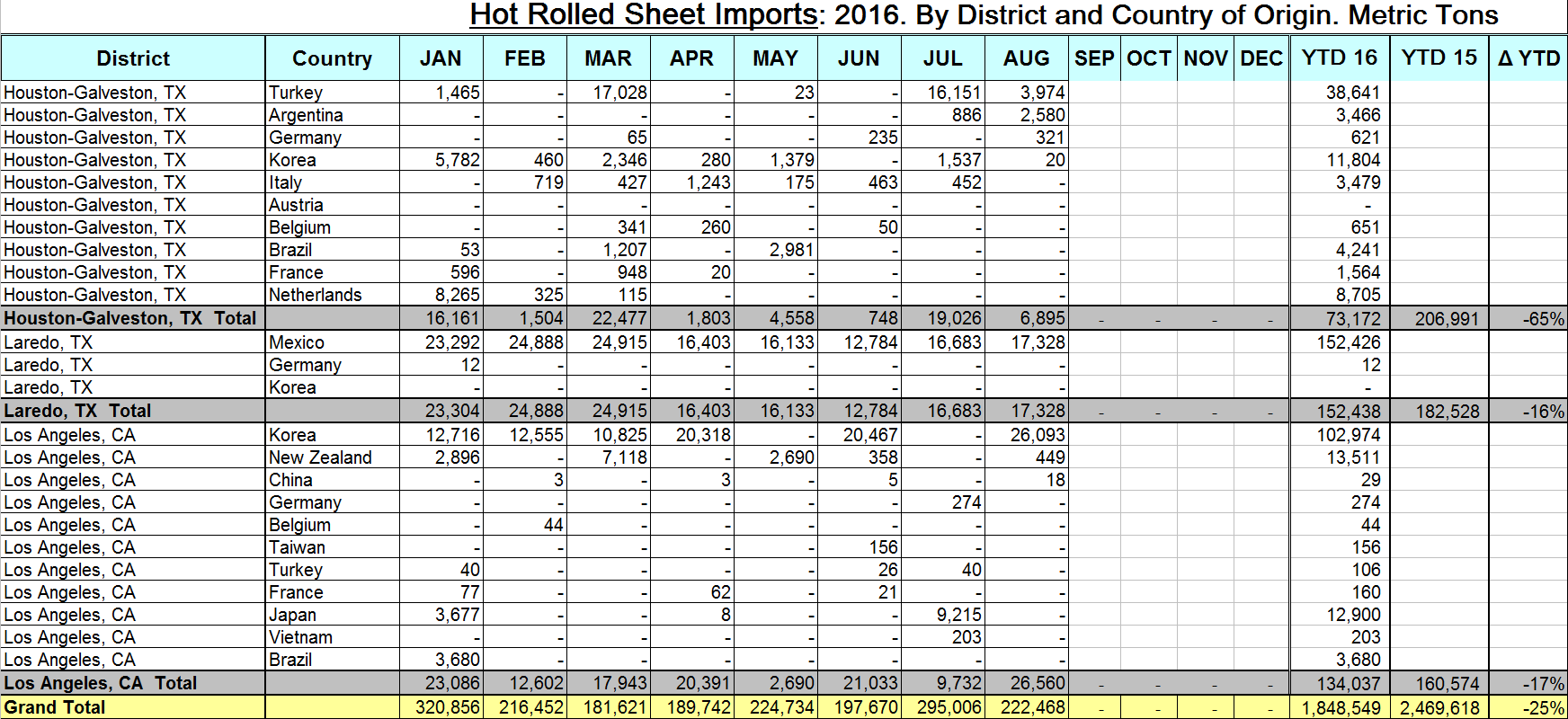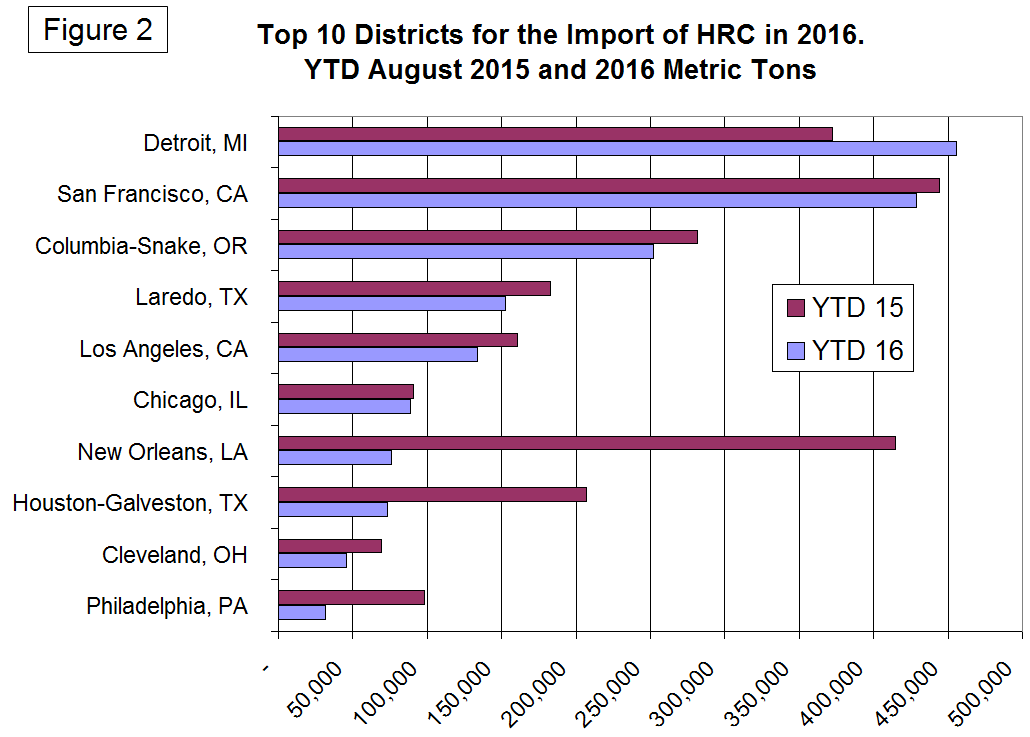Steel Products Prices North America

Analysis of Sheet Steel Imports by District of Entry and Source through August 2016
Written by Peter Wright
October 11, 2016
We believe that misinformation about regional import volumes is often used to influence purchase decisions. Our intent with this analysis of tonnage by district of entry is to describe in detail what is going on in a company’s immediate neighborhood and thus provide a negotiating advantage for our premium subscribers.
![]() We are now publishing monthly data on our website that breaks down the tonnage of the four major sheet products, HRC, CRC, HDG and Other Metallic Coated into the port of entry and country of origin in metric tons. This data set is large, therefore, we will make no attempt to provide a commentary. Each readers interest will be different and he/she simply needs to select one of the four products then find the nearest port or ports of entry to see how much came into their region each month and where from. It is clear from these detailed reports that the growth of tonnage entering a particular district in many cases bears no relation to the change in volume at the national level.
We are now publishing monthly data on our website that breaks down the tonnage of the four major sheet products, HRC, CRC, HDG and Other Metallic Coated into the port of entry and country of origin in metric tons. This data set is large, therefore, we will make no attempt to provide a commentary. Each readers interest will be different and he/she simply needs to select one of the four products then find the nearest port or ports of entry to see how much came into their region each month and where from. It is clear from these detailed reports that the growth of tonnage entering a particular district in many cases bears no relation to the change in volume at the national level.
Figure 1 is a small extract from the data sheet for hot rolled coil. It describes the tonnage that has come in through Houston, Laredo and Los Angeles and the grand total for all districts of entry. It shows where it came from, the YTD tonnage and the YTD change compared to 2015. Like all of the images in the SMU newsletters, you can click the image below to see a larger view.
The total volume of HRC into Houston in the 8 months through August was 73,172 tonnes, down by 65 percent from YTD August in 2015. Turkey was the major source followed by South Korea. The data on our web site spells this out for every port of entry around the country for hot rolled, cold rolled, HDG and other metallic coated which is mainly Galvalume.
The point is that YTD August the tonnage of HRC was down by 25 percent, Houston was down by 65 percent but Detroit was up by 22 percent. This is why we think it important for both market understanding and negotiating position to know what is going on in your own back yard.
Figure 2 shows graphically the tonnage that entered the top 10 districts in YTD August for 2015 and 2016. Detroit received the most tonnage so far in 2016 and of the top 10 Philadelphia received the least. These 10 districts received 94 percent of the total HRC import volume in the first 8 months of 2016.
The data in these detailed reports is compiled from tariff and trade data from the U.S. Department of Commerce and the U.S. International Trade Commission. Our other import reports are sourced from U.S. Department of Commerce, Enforcement and Compliance, otherwise known as the Steel Import Monitoring System. In the development of these reports by district and source country we have discovered that the SIMA data for HRC and CRC contains some high alloy steel such as stainless and tool steel which have been misclassified at the ports. These alloy steels are not included in in our detailed reports which results in a discrepancy between the two data sets for CRC, in particular, and for HRC to a lesser degree.

Peter Wright
Read more from Peter WrightLatest in Steel Products Prices North America

Nucor slows HRC price climb with $5/ton increase
After eight weeks of double-digit price increases on hot-rolled (HR) coil, Nucor slowed the price rise this week with an increase of $5 per short ton.

Domestic CRC prices surge ahead of imports
The price spread between stateside-produced CR and imports reached its widest margin in over a year.

Evraz raises plate prices $160/ton
Evraz North America (NA) has followed Nucor and SSAB with a plate price increase of its own: up $160 per short ton (st). The increase was effective immediately for all new orders of carbon, high-strength low-alloy, and normalized and quenched-and-tempered plate products, as well as for hot-rolled coil, the steelmaker said in a letter to […]

Nucor lifts HR coil to $820/ton
Nucor has increased its consumer spot price (CSP) for hot-rolled (HR) coil for a fourth consecutive week.

Nucor pushes HR spot price to $790/ton
Nucor increased its consumer spot price (CSP) for hot-rolled (HR) coil to $790 per short ton (st) on Monday, Feb. 10 – a $15/st bump vs. last week. The Charlotte, N.C.-based company has raised its weekly CSP by $40/st over the past three weeks after maintaining tags at $750/st since Nov. 12, according to SMU’s […]


